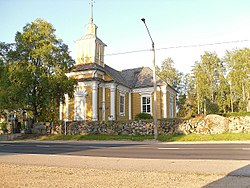Honkajoki | |
|---|---|
Former municipality | |
| Honkajoen kunta Honkajoki kommun | |
 Honkajoki Church | |
 Location of Honkajoki in Finland | |
| Coordinates: 61°59′35″N 22°15′50″E / 61.99306°N 22.26389°E | |
| Country | |
| Region | Satakunta |
| Sub-region | Pohjois-Satakunta sub-region |
| Charter | 1867 |
| Consolidated | 2021 |
| Government | |
| • Municipal manager | Ulla Norrbo |
| Area | |
| • Total | 333.13 km2 (128.62 sq mi) |
| • Land | 331.22 km2 (127.88 sq mi) |
| • Water | 1.8 km2 (0.7 sq mi) |
| Population (2020-12-31) | |
| • Total | 1,595 |
| • Density | 20.76/km2 (53.8/sq mi) |
| Population by age | |
| • 0 to 14 | 13.4% |
| • 15 to 64 | 55.4% |
| • 65 or older | 31.2% |
| Population by native language | |
| • Finnish | 96.5% (official) |
| • Swedish | 0.3% |
| • Others | 3.3% |
| Time zone | UTC+02:00 (EET) |
| • Summer (DST) | UTC+03:00 (EEST) |
| Municipal tax rate | 22.50%[3] |
| Climate | Dfc |
| Website | www.honkajoki.fi |
Honkajoki (Hongonjoki until 1952)[4] is a former municipality of Finland. It was merged with the town of Kankaanpää on 1 January 2021.
It was located in the province of Western Finland and was part of the Satakunta region. The population of Honkajoki was 1,595 (31 December 2020)[2] and the municipality covered an area of 331.22 km2 (127.88 sq mi) of which 1.8 km2 (0.69 sq mi) was inland water (1 January 2018).[5] The population density was 20.76/km2 (53.8/sq mi).
The municipality was unilingually Finnish.
References[edit]
- ^ "Population growth biggest in nearly 70 years". Population structure. Statistics Finland. 2024-04-26. ISSN 1797-5395. Retrieved 2024-04-29.
- ^ a b "Population according to age (1-year) and sex by area and the regional division of each statistical reference year, 2003-2020". StatFin. Statistics Finland. Retrieved 2 May 2021.
- ^ "Luettelo kuntien ja seurakuntien tuloveroprosenteista vuonna 2020" (PDF). Vero.fi (in Finnish). Finnish Tax Administration. Retrieved 2 May 2021.
- ^ "Historia". honkajoenseurakunta.fi (in Finnish). Archived from the original on Jan 24, 2018. Retrieved July 15, 2022.
- ^ "Area of Finnish Municipalities 1.1.2018" (PDF). National Land Survey of Finland. Retrieved 30 January 2018.
External links[edit]
![]() Media related to Honkajoki at Wikimedia Commons
Media related to Honkajoki at Wikimedia Commons
- Municipality of Honkajoki – Official website


Well, that’s interesting to know that Psilotum nudum are known as whisk ferns. Psilotum nudum is the commoner species of the two. While the P. flaccidum is a rare species and is found in the tropical islands. Both the species are usually epiphytic in habit and grow upon tree ferns. These species may also be terrestrial and grow in humus or in the crevices of the rocks.
View the detailed Guide of Psilotum nudum: Detailed Study Of Psilotum Nudum (Whisk Fern), Classification, Anatomy, Reproduction